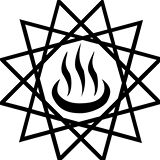by Melissa and others
(10-17 Elaphebolion) The City Dionysia (Dionysia ta astika) or Great Dionysia was an important festival in honor of Dionysos from the middle of the sixth century BCE, possibly introduced to Athens by the Tyrants. The new cult came from Eleutherai, a town on the border of Attica and Boeotia. A myth was created for the occasion at some point, claiming that a certain man from Eleutherai had attempted to bring the cult image to Athens but the god and His worship were rebuffed. In punishment, the god visited a disease upon the genitals of the men of Athens. The Delphic oracle pronounced that the Athenians must offer due honors to the god and to hold a procession carrying a phallus in recognition of their failing. When this stopped the plague, the procession and festival were instituted as a regular observance. (Parke, p. 126)
Just before the festival each year, the image of Dionysus was removed to a temple outside Athens, so that the procession carrying the image could reenact the god’s original arrival from Eleutherai. The resident aliens (metoikoi, metics) of Athens, in a typical Dionysian role reversal, wore purple robes and carried trays of offerings while the citizens wore everyday apparel and carried leather bottles of wine and long, stick-shaped loaves of bread (oboloi). Others herded large number of bulls, sacrificial victims, along the process and images of phalli were carried in the god’s honor. The god’s image was then placed in the old temple of Dionysos within the theater precinct, sacrifices and libations were offered and a large feast was held. At some point, these observances, which had always included singing and dances (as komoi, revels), began to include formal choruses and performances and eventually, dramatic competitions. Paid for by wealthy citizens, these performances were also an occasion for prominent individuals and tribes to show off.
In the 5th century, male citizens (and possibly women) would view three or four tragedies in the morning followed by a satyr play. In the later afternoon, the men (only, as far as we know) would see a comedy. Competitions of choruses singing dithyramboi (odes to Dionysos) were held, too. Such dramatic performances were never secular entertainment but always taught piety, morality and moderation, and the comedies afforded the poet a chance to make political statements that might not otherwise have been tolerated. However, spectators might applaud or hoot and usually imbibed and nibbled delicacies during the performances. Actors in the comedies were known to throw nuts and raisins to the audience. This was a festival in which foreigners could take part. (Adkins and Adkins, p. 355, and Parke, pp. 125-135)
The emphasis on drama for this holiday suggests that reading classic plays or seeing them on video might be a way of observing this holiday in modern times, as well as going to see modern live theater or attend poetry readings. Consider holding costume parties where wine is served and decorations include ivy and grape vines and guests are offered wreaths of vines and flowers, but remember to offer a libation to the god first, perhaps reading along the Homeric Hymns to Dionysos (Hymn 1 and 7) and various of the Orphic Hymns to Dionysos (30, 45, 46, 53 and even 54). Although Dionysos was the god of wildness, spontaneity, uncivilized behavior and role-reversing, make sure that you don’t endanger yourself or others while celebrating. Remember that He is the god “whom swords, and blood, and sacred rage delights” (Orphic Hymn 45, to Dionysos).
Sources:
Adkins, Lesley, and Roy A. Adkins, Handbook to Life in Ancient Greece, 1997
Parke, H.W., Festivals of the Athenians, 1977
https://www.brown.edu/Departments/Joukowsky_Institute/courses/13things/7411.html
